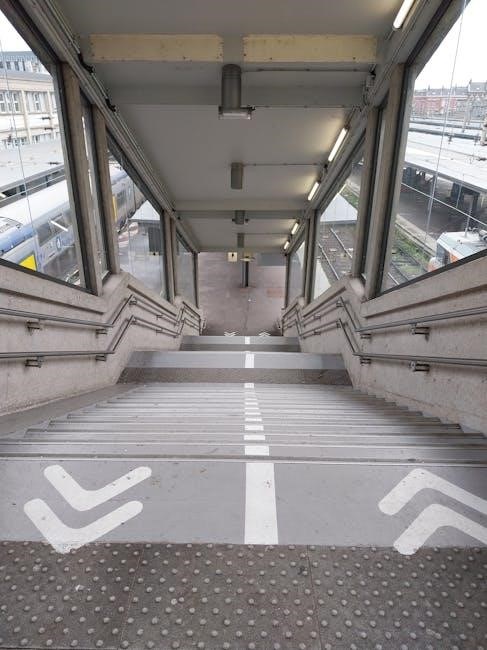Elevator guide rails are essential components ensuring smooth operation‚ safety‚ and alignment of elevator cars. They provide structural support and guidance‚ enabling seamless vertical movement in buildings. Round rails are often used in panoramic elevators for aesthetic appeal‚ while T-rails offer durability and stability. Proper installation and maintenance of guide rails are critical for reliable elevator performance and passenger safety.

Types of Elevator Guide Rails
Elevator guide rails come in two primary types: T-rails and round rails. T-rails are known for their durability and strength‚ while round rails are often used for their aesthetic appeal in panoramic elevators‚ ensuring smooth and quiet operation while enhancing visual design.
2.1. T-Rails
T-rails are a popular choice for elevator systems due to their robust design and durability. They are named for their distinctive T-shaped cross-section‚ which provides excellent structural integrity. These rails are commonly used in high-traffic environments because they can withstand heavy loads and minimize wear and tear. The T-shape allows for easy installation and alignment‚ making them a practical option for both new constructions and modernizations. Their strength and reliability ensure smooth elevator operation‚ making T-rails a preferred choice in the industry. They are also known for their compatibility with various elevator types and configurations.

2.2. Round Rails
Round rails are a popular choice for elevator systems‚ particularly in panoramic elevators‚ where aesthetics are important. Their smooth‚ cylindrical shape provides a sleek appearance‚ enhancing the visual appeal of elevator cabins. Round rails are known for their quiet operation and are often used in applications where noise reduction is a priority; They are also favored for their ability to accommodate curved or angled installations‚ offering design flexibility. While they may not offer the same load-bearing capacity as T-rails‚ round rails are ideal for lighter-duty applications and are prized for their durability and low maintenance requirements.

Materials Used for Guide Rails
Elevator guide rails are typically made from steel‚ known for its strength and durability‚ or aluminum‚ prized for its lightweight and corrosion-resistant properties. Other materials are also used.
3.1. Steel Guide Rails
Steel guide rails are widely used in elevators due to their exceptional strength‚ durability‚ and load-bearing capacity. They provide stability and ensure smooth movement of the elevator car. Steel rails are preferred in high-traffic environments because they can withstand heavy loads and last for many years. Their robust structure minimizes wear and tear‚ reducing maintenance needs. Additionally‚ steel rails are cost-effective compared to other materials‚ making them a popular choice for both new installations and replacements in various elevator systems.
3.2. Aluminum Guide Rails
Aluminum guide rails are a lightweight yet durable option for elevator systems. They are corrosion-resistant and ideal for environments where weight reduction is beneficial. Aluminum rails are often used in scenic or panoramic elevators‚ as they complement modern designs. Their smooth surface ensures minimal friction‚ which enhances the elevator’s performance and energy efficiency. Despite being lighter‚ aluminum guide rails maintain structural integrity and provide reliable support. They are also easier to install and require less maintenance compared to steel‚ making them a popular choice for contemporary elevator installations seeking a balance between aesthetics and functionality.
3.3. Other Materials
Beyond steel and aluminum‚ other materials like stainless steel‚ composites‚ and titanium are used for guide rails. Stainless steel offers exceptional corrosion resistance‚ making it ideal for harsh environments. Composite materials combine lightweight properties with durability‚ reducing overall weight and enhancing energy efficiency. Titanium‚ though more expensive‚ provides high strength-to-weight ratios and excellent corrosion resistance‚ suitable for high-end applications. These materials are selected based on specific needs‚ ensuring optimal performance‚ longevity‚ and aesthetic appeal in various elevator systems.
Manufacturing Process of Elevator Guide Rails
The manufacturing process involves machining raw materials to precise dimensions‚ followed by finishing treatments to enhance durability and meet specific elevator industry standards for reliability and safety.
4.1. Machining
Machining is a critical step in producing elevator guide rails‚ involving cutting‚ drilling‚ and milling raw materials like steel or aluminum to precise dimensions. High-precision CNC machines are used to ensure accuracy and consistency. The process involves creating the rail’s profile‚ including the head‚ web‚ and base‚ while maintaining tight tolerances. Machining also includes surface finishing to achieve the required smoothness for optimal elevator movement. This step is essential for ensuring the rails fit seamlessly with other components and function reliably under various loads and conditions‚ making it a cornerstone of guide rail manufacturing quality and performance.
4.2. Finishing Treatments
Finishing treatments are applied to elevator guide rails to enhance durability and performance. Common treatments include galvanization‚ powder coating‚ and anodization‚ which protect against corrosion and wear. These processes ensure a smooth surface finish‚ reducing friction and extending the lifespan of the rails. Additionally‚ some treatments improve aesthetic appeal‚ particularly for visible components in modern elevator designs. Proper finishing is crucial for maintaining the structural integrity and operational efficiency of guide rails‚ ensuring reliable performance under various environmental conditions. These treatments are tailored to the specific material and application‚ guaranteeing optimal results for both functionality and safety in elevator systems.

Installation of Elevator Guide Rails
Installation involves precise alignment and secure fastening of guide rails to ensure smooth elevator operation. Specialized tools and techniques are used for accurate placement and leveling.
5.1. Installation Techniques
Installation techniques for elevator guide rails require precision and alignment to ensure smooth operation. Proper tools‚ such as laser levels and alignment jigs‚ are used to achieve accurate placement. The rails are typically anchored to the building structure using brackets or clips‚ ensuring stability. Welding or bolting methods are employed to secure the rails firmly. Skilled professionals follow manufacturer guidelines to maintain alignment and prevent misplacement. Regular checks during installation ensure the system’s integrity and longevity‚ guaranteeing safe and efficient elevator performance over time.
5.2. Tools and Equipment Required
The installation of elevator guide rails requires specialized tools to ensure precision and safety. Essential tools include drills‚ wrenches‚ and measuring tapes for accurate alignment. Laser levels and alignment jigs are crucial for maintaining proper positioning. Additionally‚ safety harnesses and safety glasses are necessary to protect workers during the process. Hydraulic lifts or elevator shaft access equipment may also be needed for reaching high areas. These tools collectively ensure the guide rails are installed correctly‚ providing stability and alignment for smooth elevator operation. Proper equipment is vital for both efficiency and safety in the installation process.
Maintenance and Repair of Guide Rails
Regular maintenance of elevator guide rails is crucial to ensure their longevity and performance. Inspections should be conducted periodically to identify wear and tear. Cleaning the rails from dirt and debris is essential to prevent friction. Lubrication of moving parts helps reduce wear and ensures smooth operation. Minor repairs‚ such as tightening loose fasteners‚ should be addressed promptly. For severe damage‚ professional technicians may need to replace or realign the rails. Neglecting maintenance can lead to misalignment‚ increased wear‚ and potential safety hazards. Proper care ensures reliable and safe elevator functionality over time.
Role of Guide Rails in Elevator Safety
Guide rails play a pivotal role in ensuring elevator safety by providing structural support and maintaining proper alignment of the elevator car. They prevent the car from deviating from its path‚ reducing the risk of accidents. Smooth operation is maintained by minimizing friction and wear‚ which is critical for safe passenger transport. Additionally‚ guide rails contribute to shock absorption‚ protecting the system from sudden impacts. Their stability ensures that safety mechanisms‚ such as braking systems‚ function effectively. Regular inspection and maintenance of guide rails are essential to uphold their role in safeguarding elevator operations and passenger well-being.
Innovations in Elevator Guide Rail Technology

Recent advancements in elevator guide rail technology focus on enhancing durability‚ reducing maintenance‚ and improving energy efficiency. Self-lubricating materials minimize friction‚ extending rail lifespan. Lightweight yet robust designs‚ such as hollow steel rails‚ reduce weight while maintaining strength. Innovations like adaptive guide rails adjust to temperature changes‚ preventing misalignment. Additionally‚ smart sensors embedded in rails monitor wear and tear‚ enabling predictive maintenance. These advancements ensure smoother‚ quieter‚ and safer elevator operations while reducing environmental impact. Such innovations are transforming the industry‚ offering solutions tailored to modern architectural and functional demands.

Challenges and Limitations of Elevator Guide Rails
Elevator guide rails face challenges such as wear and tear from constant use‚ leading to potential misalignment and operational issues. Environmental factors like humidity and temperature fluctuations can cause corrosion or degradation of materials. Additionally‚ the precision required for installation increases the risk of errors‚ while material limitations may affect performance in extreme conditions. Addressing these challenges requires regular maintenance‚ high-quality materials‚ and advanced installation techniques to ensure reliability and longevity.
